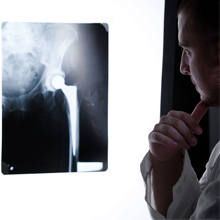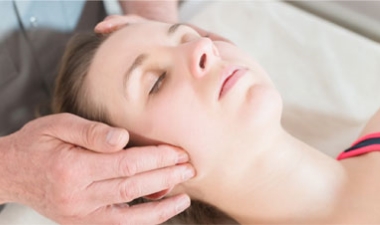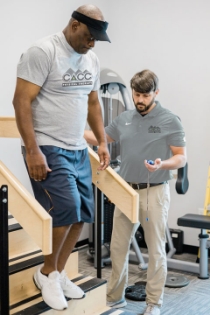
Services Provided
In order to provide full service care, CACC has developed many specialized programs. Please take a look into some of the following:
-
Massage Therapy
Powerful tool for injury recovery
Massage Therapy can be a powerful tool in the recovery process, when used in conjunction with skilled physical therapy. Massage has been shown to release Serotonin, a hormone that is necessary to prevent depression and migraine headaches. Massage Therapy has also been shown to:- Relieve muscular aches and pains
- Reduce scar tissue restrictions
- Calm the central nervous system
- Increase circulation
- Lower blood pressure
- Relieve stress
- Enhance sleep
- Circulate the lymphatic system, pumping out harmful toxins like Lactic acid
- Help you relax and feel better about yourself.
Techniques:
Please call the location most convenient to you to inquire about massage services.At CACC, our physical therapists and massage therapists coordinate treatments in order to provide the maximum recovery for patients.
-
Manual Therapy
Facilitates improved function

Manual Therapy is a very powerful tool in the rehabilitation process. Manual therapy is performed with the therapists’ hands, and not by machines.
Manual Therapy includes:
- Mobilization – This technique uses slow, measured movements in order to twist, pull, or push bones and joints into position. Mobilization can help loosen tight tissues around a joint and help with flexibility and alignment.
- Manipulation – This technique uses rapid, forceful movements to position the bones and joints. Manipulation is a more aggressive form of treatment.
- Massage – This technique applies pressure to the soft tissues of the body, the muscles. Massage can help relax muscles, improve circulation, and ease pain in the soft tissues.
Throughout your lifetime you may learn to, or are forced because of an injury or stress, into moving or holding your body in an unnatural way. This unnatural movement or posture changes the natural alignment of bones, which in turn causes discomfort and may contribute to health problems. By utilizing Manual Therapy, you are working toward the goal of relaxation, decreasing pain, and achieving more flexibility.
For more information, call us at the clinic most convenient to you, so we may answer any questions specific to your needs.
-
Pre-Post Surgical Care
Improve Strength and Motion

CACC offers a rehabilitation program for patients who are anticipating surgery by offering care before and after surgery. Before surgery, a patient can expect to be educated by a therapist about all aspects of the upcoming surgery, including exercises (both pre- and post-operative), how to reduce pain and swelling, and what their goals for physical therapy should be before and after. Therapists remain in close communication with the referring physician in order to fully understand what surgery the patient is undergoing and to prepare an individual pre- and post-operative treatment plan.
Benefits of physical therapy pre- and post-operative include:
- Help with pain management
- Reduction of swelling before and after surgery
- Increased mobility
- Reduced recovery time
- Increased comfort levels pre- and post-operative.
Therapists maintain communication with the patient after the surgery, track the patient’s progress with the referring physician, and make any modifications to the treatment plan based on the individual patient’s progression.
For more information, call us at the clinic most convenient to you, so we may answer any questions specific to your needs.
-
Graston Therapy

The Graston Technique is a modern way to detect and treat areas of chronic inflammation or soft tissue fibrosis (scar tissue). Based on the concept of Cross-Fiber Massage, clinicians use specially-designed stainless steel instruments to locate and break up the scar tissue that causes the problem, greatly improving the patients range of motion and reducing pain.
-
Pediatric Physical Therapy

Children are becoming involved in competitive sports, dance, and other physical activities at a younger age than ever before. This increased activity level has placed children at a greater risk for developing injuries, such as common musculoskeletal disorders like sprains, strains, and tendonitis.
CACC treats a large number of pediatric and adolescent conditions. Our physical therapists are skilled at treating general pediatric conditions, as well as orthopedic injuries.
During the course of rehabilitation, we consult with the patient’s and their parents regarding the child’s progress.
-
Warm Water Pool Therapy
Rehabilitate and get back in shape
 Available at these locations
What to bring
Available at these locations
What to bring
Comfortable and functional swim wear
Towel and toiletries
Swim cap (if desired)
Pool foot wear (flip-flops, Teva's, etc. if desired)
Lock for personal belongings in locker room Aquatic therapy is an alternative or adjunct to traditional physical therapy. Did you know that if you exercise in chest-deep water you are only under 10% of your body weight stress? This helps those individuals who cannot tolerate weight-bearing stresses with traditional exercise, or for those who are under post-injury or surgical weight-bearing restrictions. The beauty of aquatics is that the water can give you both resistance and buoyancy. Aquatics therapy is not only good for initial therapy, but also for high-level performance training.
Aquatic therapy is an alternative or adjunct to traditional physical therapy. Did you know that if you exercise in chest-deep water you are only under 10% of your body weight stress? This helps those individuals who cannot tolerate weight-bearing stresses with traditional exercise, or for those who are under post-injury or surgical weight-bearing restrictions. The beauty of aquatics is that the water can give you both resistance and buoyancy. Aquatics therapy is not only good for initial therapy, but also for high-level performance training.- All CACC pools are warm water.
CACC’s aquatic program is beneficial for treatment of the following conditions:
- Limited weight bearing
- Post-surgical
- Arthritis
- Fibromyalgia
- Failed traditional therapy
- Osteoporosis
- Tendonitis and Bursitis
- Chronic Pain
- Swelling/edema
- Back Pain
- Obesity
For more information, call us at the clinic most convenient to you, so we may answer any questions specific to your needs.
- Aurora Pool
- Lowry Pool
- Parker Pool
-
VRT – Vestibular Rehab Therapy

VRT Physical Therapy will identify (by our vestibular physical therapist specialist),Impairments, functional limitations and disabilities on the initial visit. Once the conditions are identified, the physical therapist develops a specialized plan of care that will help focus on improving these deficits.
The goal of physical therapy for vestibular disorders is to get the patient comfortable moving their head to reintegrate the vestibular system and to prevent any unnecessary falls due to their symptoms. Physical therapy may also include: posture education, ergonomics, strengthening, stretching, balance retraining and promoting generalized fitness.
Who is vestibular rehabilitation for?
Patients diagnosed with dizziness, imbalance, vertigo, frequent falls, Menieres, benign paroxysmal positional vertigo (BPPV), neck related dizziness or migraines.
Some examples may include: lightheadedness, vertigo (spinning), wooziness (swimming feeling in head), imbalance (unsteadiness), and syncope (the feeling of passing out). These symptoms can last in duration from seconds to days and may also vary in frequency from daily to intermittently.
-
Trigger Point Dry Needling

Trigger Point Dry Needling is a technique that uses small needles to deactivate trigger points and loosen shortened muscles. The primary goal of dry needling is to desensitize super-sensitive structures, to restore motion and function, and possibly induce a healing response in the tissue. This is a valuable treatment for musculoskeletal-related pain such as muscle and joint pain. The treatment can also help to increase muscle performance.
-
Work Injury Programs
Quickly return to work

Our Work Conditioning program focuses on providing a goal-orientated treatment plan to prepare individuals injured on the job for a successful return to the workplace. Individuals, employers, and our therapists all strive to return injured workers to their job as soon as they can.
To help these individuals achieve that goal, our program includes:
- Job-specific body mechanics training
- Workstation ergonomic evaluations
- One-on-one education with a therapist to discuss treatment goals, concerns, and track progress as the conditioning progresses
- Active communication with employers and insurance adjusters to get the injured individual the treatment needed to make sure the process of returning to work happens without delay
Each employee is given an individualized exercise program to help them achieve a physical condition that is better than their pre-injury status.
Each injured worker is different and requires an individual evaluation to plan a program that is beneficial to the worker.
For more information, call us at the clinic most convenient to you, so we may answer any questions specific to your needs.
-
FMS- Functional Movement Screening


Do you get back pain while golfing? Are you continually pulling a hamstring playing football? Have you tweaked your hip while kicking the winning goal? These could all be the result of asymmetries, weaknesses, or imbalances in your fundamental movement patterns.
Our functional movement screening (FMS) provides a standardized approach to assessing fundamental movement, identifying limitations and asymmetries, and developing an individualized corrective exercise program.
Benefits of the FMS include:
- Improved functional fitness and athletic performance
- The development of a personalized fitness plan
- The identification of dangerous weaknesses before injury occurs
- The identification and resolution of movement problems
- A plan to build lasting fitness
- A way to measure your progress.
-
Female Jump Assessment


-
11 Components of Physical Fitness

Your Physical Therapist will incorporate all components of physical fitness into our clients training programs. These components play an important role in ones daily activities. Improving upon all areas of physical fitness will help you to improve daily activities and maintain a healthy lifestyle.
-
Office Workstation Health Tips

Faulty computer habits can have painful consequences. Sitting too long at the computer without moving around or changing position can result in repetitive motion disorders and muscle strain. Physical therapists recommend that you keep your feet flat on the floor, sit up straight, keep your eyes level with the screen, and take mandatory breaks at least every 20 minutes to avoid muscle fatigue.
Physical therapists can detect early symptoms and develop an Intervention Program that includes stretching, exercise, and adjustments to the over all work environment.
-
Posture Health Benefits

Good Posture Promotes Better Health
Posture is an important consideration in all activities of daily living (e.g., walking, lifting objects, holding objects and driving) and that keeping good posture can make a considerable difference to the long-term health of the spine. Many postural problems are detectable at very early stages, regardless of age. If not corrected, these issues will become more pronounced.
-
Throwers’ Screenings
 What to bring
What to bring
Towel
Throwing injuries are at epidemic levels. About 50% of nine- to 14-year-olds old complain of shoulder pain, while 44% of nine- to 14-year-olds old complain of elbow pain.
Our thrower’s screening can help minimize the risk of injury and re-injury by identifying problematic pitches, as well recognizing bad mechanics. In the screening, we will emphasize pre-throwing warm-ups, stretching, proper body mechanics, and the importance of weight training.
Our screening program is offered free of charge and is done at our facility or your team practice location. We work with players of all ages, little league to major league, in a diligent effort to prevent throwing arm injuries.
-
TRX Suspension Rehabilitation
- TRX Suspension Training is a revolutionary method of leveraged body weight exercise being used by pro athletes, fitness facilities and specialized physical therapy clinics. TRX users can safely perform hundreds of exercises that can build power, strength, flexibility, balance, and mobility. In addition to training, physical therapists are now using TRX to rehab patients and athletes.
- TRX is a wonderful tool for all levels of patients. Users can easily adjust the resistance to meet their needs, while challenging muscles in multiple planes. Multi-planar movements are much more functional than standard one plane exercises. The result is more specific training that is more similar to how we actually use muscles.
-
TMJ Therapy
The temporomandibular joint, or TMJ, connects your jaw to your skull in front of your ear. The TMJ hinges, allowing you to move your mouth when you talk, yawn, or chew. TMJ disorder is pain in and around your jaw. It may also include popping/clicking, ringing in the ears, headaches, limited mouth opening or a tendency for the jaw to “lock”. Physical therapy can be used to treat those symptoms by restoring proper jaw movement and lessening daily stress on the jaw.
 Physical Therapists Can Help with TMJ Dysfunction Caused By:
Physical Therapists Can Help with TMJ Dysfunction Caused By:- Bad posture habits
- Chronic jaw clenching & poor sleep hygiene
- Problems with teeth alignment
- Fracture
- Surgery
- Trismus (lockjaw)
- Displacement of the disc
- Arthritis
Did You Know?
It is estimated that up to 25% of the population has pain associated with TMJ, but only 3-4% actively seek treatment. Physical therapy can serve as an essential preventative measure as well as a physical rehabilitative resource.
How a Physical Therapist Can Help
TMJ dysfunction ultimately results in functional limitations due to pain or impaired movement, regardless of its original cause. Physical Therapists specialize in the restoration of movement patterns, including those of the facial region. They may use the following techniques to reduce symptoms:
- Reduce acute pain and inflammation using treatments like electrical stimulation or ultrasound
- Decrease compressive forces in the joint with manual therapy techniques
- Improve motor patterns associated with talking and chewing via specific exercises
- Promote awareness of postural and lifestyle factors that contribute to TMJ dysfunction
-
Women’s Health Therapy
Our commitment to physical therapy for women’s health starts with a specialized group of Physical Therapists with training specifically for the treatment and education of women’s health issues. Our team provides physical therapy care to women with pelvic pain or dysfunction. As a patient, you will receive the best one-on-one care in a private setting to help get you back to enjoying the activities that you love. CACC Physical Therapists are experienced and caring clinicians that women can trust.
We start with a physical therapy women’s health evaluation, which includes discussing the history of the problem(s), experiences with pain, previous treatment, and functional limitations. We then assess muscle strength, posture, and movement patterns. An internal pelvic floor assessment may also be completed based on comfort level and consent. After this information is collected, our therapists will develop a treatment plan and goals.

- Private – One-on-One
- Safe Secure Setting
- Comprehensive Evaluation
- Individualized Multi-modal Care
We specialize in treating the following conditions:
Urinary Incontinence – Treatments for both stress and urge incontinence include strengthening exercises for weakened pelvic floor muscles, education on fluid, diet, lifestyle modifications, and biofeedback training.
Chronic Pelvic Pain – Treatments include muscle re-education/strengthening/relaxation exercises. Functional activity of daily living alternatives, postural education, soft tissue massage, spinal/pelvic alignment corrections, and biofeedback training.
Sacral Dysfunction – Treatments include manual techniques/mobilizations/muscle energy techniques, flexibility for the lower back/lower extremity muscles, strengthening of core/hip stabilizers and pelvic floor, and patient education.
Pregnancy and Postpartum – Many changes occur to the body during pregnancy, and some of them result in pain and discomfort. The therapists at CACC Physical Therapy are experts at evaluating and treating pregnancy-related conditions such as diastasis recti, prolapse, carpal tunnel syndrome, sacroiliac joint dysfunction, low-back pain and “sciatica,” pubic symphysis dysfunction, and coccyx (tailbone) injury.
-
Functional Capacity Evaluation Services
Available at these locations
A FCEs primary purpose is to determine an individual’s functional abilities and limitations in the context of a safe environment while focusing on productive work tasks.
The service we provide is a valuable tool in assessing an employee’s safe working abilities and/or establishing baseline abilities for disability evaluations.
Our FCE correlates a client’s functional abilities to the essential physical demands of their job to determine whether they meet these physical demands.
Consistency of effort and reliability of pain ratings are important elements of our evaluation, which is why over 70 separate criteria throughout the FCE help determine if a client is putting forth consistent effort and whether their subjective pain ratings are reliable.
Additionally, the Functional Capacity Evaluation testing method we use has consistently stood up in a court of law with reliability and validity research to support the testing method.
Software and Report Benefits
- One-page cover letter outlining a client’s results
- Considered the best and easiest-to-read FCE reports on the market
- Most important information appears on the first pages of the report
- Can easily perform workers’ compensation, disability and personal injury FCEs
- The latest FCE research is incorporated into our testing so you know your findings will stand up to legal scrutiny
- Perform and generate results the same day
-
Vestibular

 Vestibular Rehab Therapy
Vestibular Rehab TherapyCACC Physical Therapy provides vestibular rehabilitation to help patients regain their independence and get back to enjoying the activities they love. Experienced CACC clinicians treat individuals with vestibular and balance disorders by using a customized, non-invasive therapy in the treatment of vestibular disorder symptoms to alleviate symptoms and increase functional abilities.
Our vestibular rehab program can help patients:
- Improve Balance & Confidence
- Enhance Mobility & Safety
- Resolve Dizzy Spells
- Reduce Fear of Falling
- Improve Quality of Life
The Goal of Vestibular Rehab
- Decrease or eliminate dizziness/vertigo
- Improve balance function and safety
- Improve visual motor control and tolerance of motion
- Increase activity levels
- Reduce falls or risks for falls
Treatment may include exercises that can eliminate the cause of the symptoms and help the brain adapt to abnormal signals. If patients are experiencing symptoms of:
- Dizziness or Light-Headedness
- Vertigo (spinning sensation)
- Imbalance or Unsteadiness
- Decreased Concentration
- Foggy or Fuzzy Headedness
- Visual Blurring or Bouncing
- A Feeling of Being “Spacey”
- Falling, or Near Falls
- Motion Sickness










